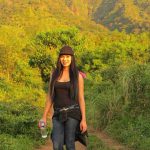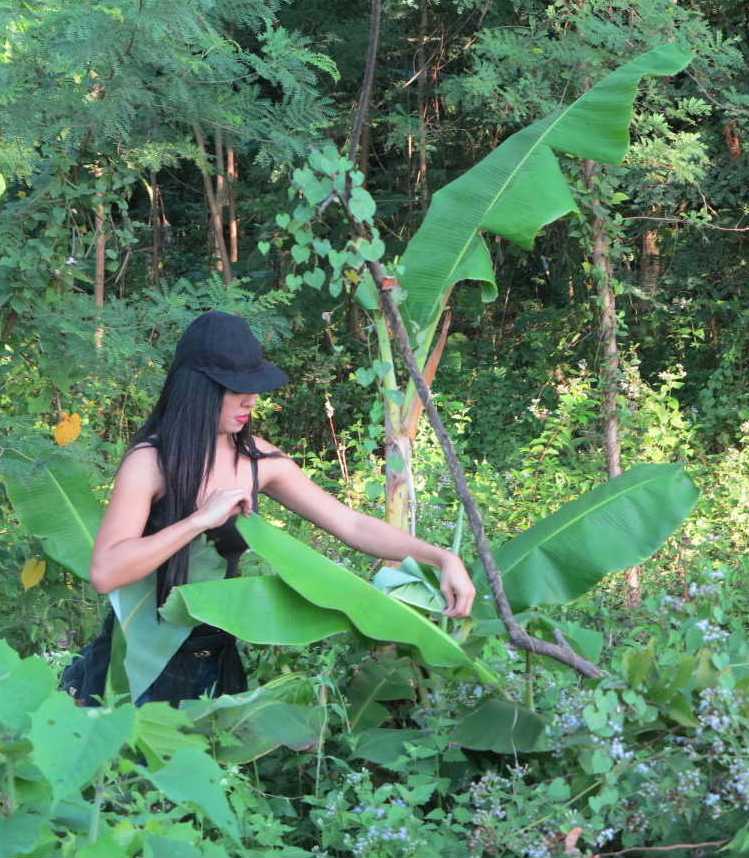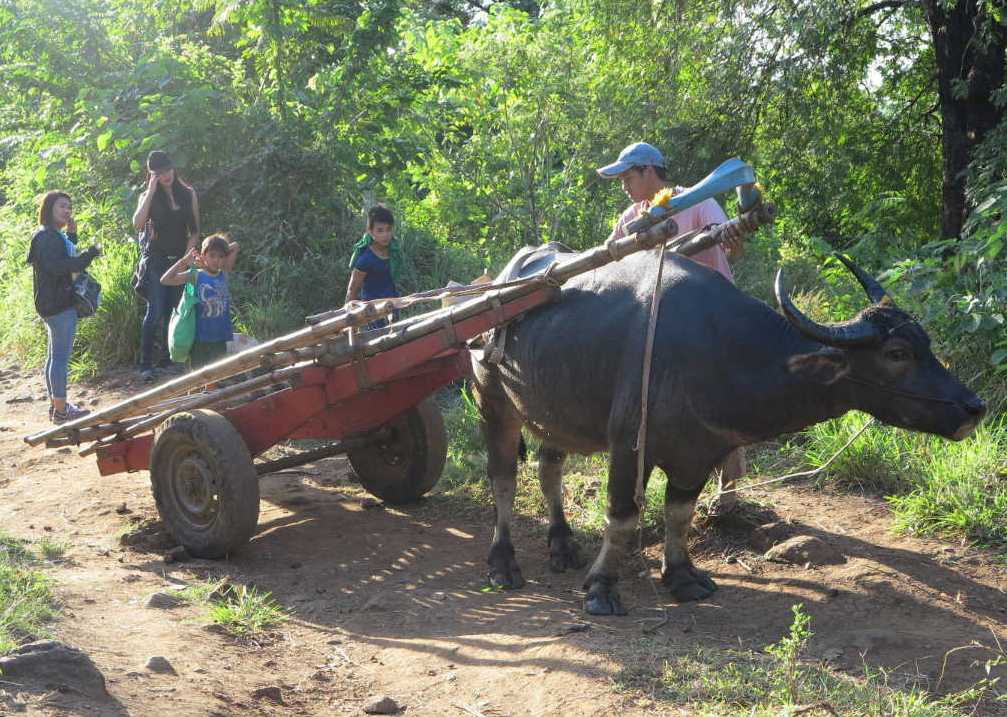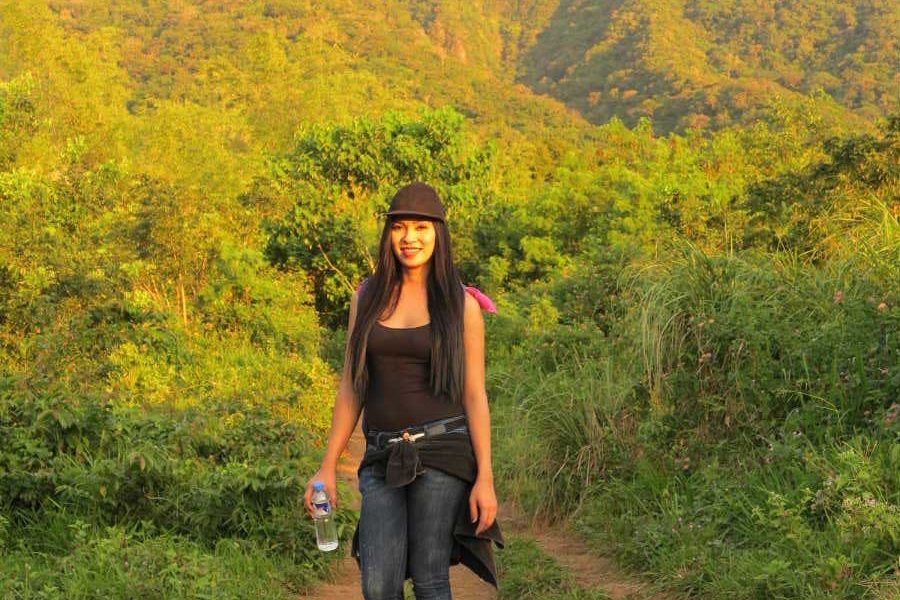Originally posted 2016-03-07 10:32:53.
 A couple of weeks ago I went to Mount Arayat National Park in Pampanga, here in the Philippines.
A couple of weeks ago I went to Mount Arayat National Park in Pampanga, here in the Philippines.
I’d been invited by some friends to spend the day, with a walk in the mountain park in the morning followed by socialising later. This meant first taking a bus to San Fernando and then another, local bus. We wanted to be there for sunrise, which is why I found myself sitting in a taxi at 3.30 am, hurtling through Quezon City at speeds in excess of 100 kph. It was a good adrenaline rush to start the day.
I took a Victory Liner coach from Cubao. Many of the coach lines have terminuses there, and the other that serves Pampanga is Genesis. (Yes, the biblical one; this is the Phils.) The fare to San Fernando is 102 pesos. You can pay on the bus but during office hours there’s a ticket office which they prefer you to use. You can also get refreshments in the terminus.
As ever, food and drinks vendors boarded the coach to ply their wares before we set off. The journey time to San Fernando is roughly an hour, depending on traffic, following the North Luzon Expressway (NLEX). Be sure not to get off at the first stop in San Fernando, wait till you get to ‘interchange’.
I was to meet my friend Azumi Ballesteros and some others for the morning walk, but in the end only Azumi and another girl called Chin showed up. Two others had said they would come but hadn’t, and this had clearly annoyed Azumi; she has a sparkly nature, quick to anger but as quick to forgive.
After exchanging greetings we boarded another bus, which took us close to the Park entrance. Then, in true Pilipino style, we boarded a trisikel (a motorcycle and sidecar) for the last part of the journey.
Unfortunately, Azumi hadn’t checked the opening time of the park, which was 6 am, and we arrived at 5.30. No matter, the security rustled up some chairs in front of a television to divert us while we waited, and even made us hot drinks. I think mine was tea, but I’m not sure; as ever the main thing I tasted was sugar. It’s one of the charms of this country, though; everybody shares, even if they have a sweet tooth that would make a Westerner’s eyes water.
At six the official ticket-seller arrived and we began our walk up the hill. The first part is a steep and very uneven staircase called the Hundred Steps. It’s far more tiring than it should be, because of the difference in the heights between the steps; fortunately there’s a good handrail which allows the less than super fit (i.e. me) to haul themselves up. I noticed that Azumi and Chin had no problems though. Ah, youth.
After the Hundred Steps, the trail debouches (love that word) onto a metalled road for half a mile or so, and then becomes a rough trail through the forest again.
The Philippines jungle is actually a delight to walk in. There are very few nasty insects, unlike jungles elsewhere, to bite and make life misery for the walker, and even the flies are not numerous. I don’t know why this is, but Philippine jungles feel fresh and healthy, even when the temperature climbs.

But it is still jungle and one always has that sensation, as one does in any jungle, of being watched by myriad hidden eyes. I imagined how soldiers must have felt — and still feel — campaigning through country like this. I thought I was being watched by hundreds of shy animals, but the eyes could easily have been those of a predator or a hostile enemy. To patrol in country like this would be nerve-wracking. I grew up during the period of the Vietnam War but it was only much later, when I began to visit jungles, that I realised what that must have been like and why it was so traumatising for the US soldiers.
We were chatting about this as we walked and Azumi agreed.
‘My friend told me it’s really dangerous here.’
‘Is it? Why?’
‘There are NPA (New People’s Army) hiding in the forest,’ she replied, with her characteristic lisp.
Involuntarily, I looked around. The NPA, or in Filipino, Bagong Hukbong Bayan, are the armed wing of the Philippines Communist Party.
They appeared in the late 1960s and during the Marcos era their ranks were swollen by young people disaffected by the dictator’s brutal regime. Ever since they have been responsible for a trickle of killings, kidnappings and other banditry.
I am aware that as a European, I am a target that they might consider to be worth cash money; the fact that nobody would pay it would mean I would disappear.
https://www.rodfleming.com/photographs/2016-01-04-arayat-national-park-pampanga/
While I shrug off Azumi’s worries, it’s true that you could hide hundreds of armed guerrillas in this jungle and not only would nobody ever know, they would be completely self-sufficient. The jungle is literally a larder. There is fruit hanging from the trees to pick and vegetables growing everywhere. The wildlife is rich and while we, as noisy townies, see only birds, there is certainly an abundance of game.
I confirm this in discussion — Azumi translating — with one of the park wardens, who double as guides. He has stopped us to ask where we intend to go, and suggests a viewpoint a few hundred metres higher up. I mention the NPA and he nods. ‘Maybe. You must be careful and stay on the path.’ I personally can’t see how this would make me less likely to be kidnapped, but I let it pass.
I point to the densely-forested peak of Mount Arayat itself, looming above us. He makes a face. ‘It’s four to six hours up there and the same back. And you can’t go alone, you need a guide. We can sort that for tomorrow, but I’m booked today.’
As well as the NPA, it turns out, whose presence the warden is being coy about, a more mundane cause of danger exists. The path is not well marked and the unwary can wander off it and get completely lost. He explains that recently a party of Germans did just that and it took six hours of search the next day to locate them.
‘They were out in the jungle all night,’ explains the warden. ‘Now we don’t let people go up without a guide.’ I can see that Azumi is quite satisfied with this answer, although I’m not quite. Being a nosey journalist.
Why so dangerous in the dark? I suppose there are animals but there are no large predators; the most dangerous terrestrial fauna here are snakes and I remain unconvinced about the NPA. I think the real issue lies in the Filipino’s terror of the dark. I have encountered this before.
Filipinos are deeply superstitious and believe in a range of truly nightmarish supernatural beings that populate the night. These are not casual beliefs in the way that some people think it’s unlucky to walk under ladders or go anti-clockwise round churches. These are real, visceral beliefs in a spirit world that is not only immediately present, but a genuine threat to humans. These spirits, which range from the kapre, a dark-skinned, cigar-smoking, but usually harmless man* who sits up trees watching people, through the engkanto, and to the truly horrific aswang, a genus of ghouls that feed on people, only appear at night.

I am pretty sure this is the real reason the warden is so emphatic that it is dangerous to be out in the jungle in darkness; compared to the monsters of the mind that infest the darkened jungle, the NPA are small beer.
Research into these fascinating ideas, which I’ll go into another time, throws light on the Philippines’ history. Although the originals of the demons existed long before the Spanish came, these colonial overlords used them to terrify the people out of living in the forest and come to live in the towns where they could be better controlled. They slaughtered natives — who may or may not have been campaigning against them — mutilated the bodies and put them on display, claiming that this was the work of the aswang and other creatures of the night.
This, apparently, worked and to this day Filipinos are extremely nervous about being in the forest after dark.
The friendly warden led us a little further up the path and pointed out the viewpoint, then struck off on another trail. Despite the terrors of the night and the poor pay, this was a man with a great job, I reflected.

Azumi, Chin and I reached the viewpoint at around 11, by which time the day was heating up. The most prominent feature was a massive rock, black basalt, which must have been blown out by Arayat when it last erupted and looking around I could see dozens of other, similar rocks. The destruction wrought by these must have been enormous. This individual rock must have weighed 300 tonnes or so; the power needed to blast it up into the air from the crater itself, at least two miles away, is truly humbling. Mother Earth is not just the nurturing goddess that brings life, but the Dark Goddess of death and destruction. To the Sumerian she was Ereshkigal, to the modern Hindu Kali; but she has always been with us, her body the dread portal into death. Arayat, thankfully dormant for now, is where she spews her vengeful anger.
(Arayat is considered to be the home of goddess Mariang Sinucuan, the archrival of Namalyari of Mount Pinatubo.)
At the rock we sat and some sticky sweet rice cakes, called malagket, which Azumi had brought. I can attest to the sugar content of these and confess I couldn’t eat all of mine, while the girls munched away happily.
Azumi and I climbed to the top of the basalt. The view was magnificent, even though it was a little limited by the heat haze. I could see Olangapo to the southwest, and, closer but still distant, San Fernando. Azumi pointed out other towns.
After a relaxing break we set off down the path again. It was very broken and obviously in times of rain, serves as a temporary river. I had noticed, on the way up, large deposits of manure that looks like they originated in something that was not quite a cow and neither a horse, and to my delight we discovered the source: a carabao. This is a kind of buffalo, and here it was being used by the licensed charcoal-burners who exploited the fallen wood to transport their produce back down the mountain. We watched as one, a female, was hitched into a cart. She seemed very placid and later we discovered more wandering loose. Nobody seemed to bother.

As we reached the lower levels we became aware of the heat; on the slopes the breeze had kept us cool, but here the trees were much bigger and sheltered us from it. There were many more people around by now and, as usual, everyone greeted us politely.
Once down near the entrance once more we stopped at one of the ‘cottages’ under the trees and the girls set out lunch — barbecued fish, meat and salad. I took a few pictures and we headed off to get a bus back to San Fernando.
*It is widely believed that a tree at the entrance to Malacanang Palace, the Philippines President’s official residence, is inhabited by a kapre, whose role here seems to be of supernatural protector.
See many more pictures HERE
https://www.rodfleming.com/2018/09/18/2016-01-04-arayat-national-park-pampanga/





